Plant foliage significantly adds color, liveliness, and warmth to both indoor and outdoor spaces. This is especially observed in plants that have red and green leaves. Whether these leaves are bright and vibrant or subtle and cool, you can never go wrong with them!
Plants with red and green leaves are the Angel Wings, Bromeliad, Crosby’s Prolific, Fittonia, Jelly Bean Plant, Lipstick Echeveria, Madagascar Dragon Tree, Painter’s Palette, Red Heart Philodendron, Salsa Rex Begonia, Ti Plant, Wandering Jew, and many more!
This article provides you with everything you need to know about plants with red and green leaves, their physical attributes, distinctive characteristics, growing requirements, and other interesting information. Read further for more!
26 Plants With Red and Green Leaves
Angel Wings
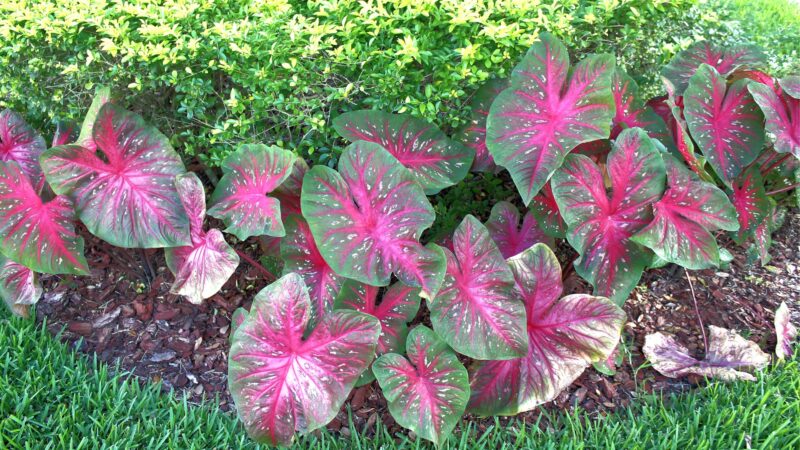
Known for their heart-shaped foliage, which has strikingly colored and patterned margins and midribs, which can be combinations of red, white, green, pink, and/or rose, Angel Wings are considered old-fashioned, tropical perennials since they have been cultivated since the 18th century in Europe.
- Botanical Name: Caladium
- Origin: South and Central America
- Family: Arum (Araceae)
- Height: 1 to 2.5 feet
- Watering requirements: Water whenever new growth emerges in the growing season. When the plant enters dormancy, stop watering completely, then resume again in the spring.
- Light and Temperature: Best suited for locations with bright, indirect light, high humidity, and temperatures of 70ºF or warmer.
- Fertilizing: Feed during the growing season using a balanced formulation or a fertilizer that is low in nitrogen. Do not allow fertilizer to sit on the leaves.
- Soil: Grows well in moist, organically-rich, well-drained, loose soil. Amend with compost or other organic material for the best results.
Bromeliad
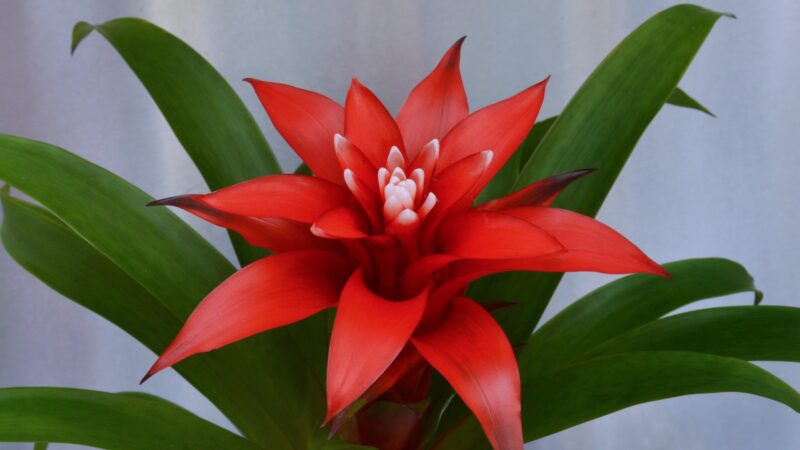
Bromeliads refer to a family of plants composed of about 2,500 species and a thousand cultivars and hybrids. Most of them grow in the ground, while some are considered air plants that grow on rocks or trees. They are commonly found in tropical and subtropical regions and are used in outdoor ornamental plantings. In temperate areas, they are grown as indoor plants.
- Botanical Name: Bromeliaceae
- Origin: North and South America
- Family: Bromeliad (Bromeliaceae)
- Height: 1 inch to 3 feet
- Watering requirements: During warmer months, water once every 1 to 2 weeks. In colder months, water once every 2 to 3 weeks.
- Light and Temperature: Requires bright light, especially those belonging to a genus that is drought-tolerant. Some species can tolerate low light conditions. The best temperature range is 70ºF to 90ºF.
- Fertilizing: Use an acidic, water-soluble fertilizer that is diluted to one-fourths to one-eighths of its strength. You can also use a slow-release fertilizer when planting indoors.
- Soil: Any type of soil or potting mix can be used as long as it is acidic, can hold moisture, and is well-draining.
Chinese Evergreen
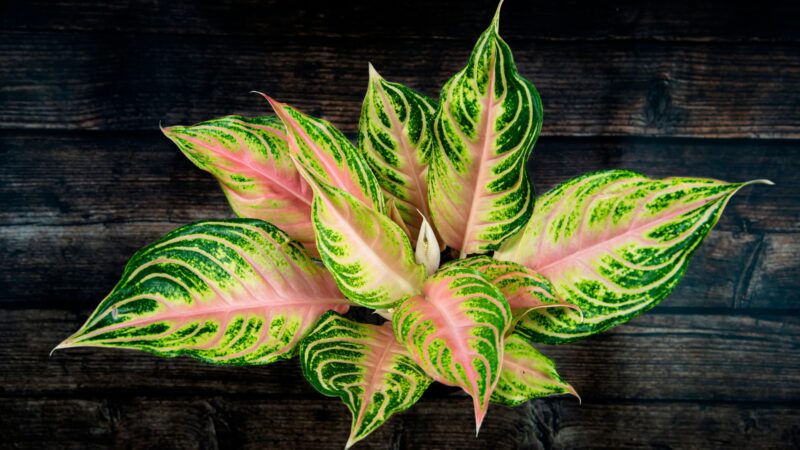
A tropical, herbaceous plant grown for its ornamental, lance-shaped foliage which is green in color and variegated with red, silver, or gray depending on the cultivar. Additionally, the Chinese Evergreen also grows clusters of red berries. It is extremely tolerant to poor growing conditions, making it an easy plant to grow for beginners.
- Botanical Name: Aglaonema commutatum
- Origin: Southeast Asia
- Family: Arum (Araceae)
- Height: 1 to 3 feet
- Watering requirements: Requires consistent moisture but needs a reduction in watering during the winter season. The plant should be allowed to dry between waterings.
- Light and Temperature: Can grow in low light conditions but prefers good, indirect light or diffused sunlight, high humidity, and temperatures of 68°F to 77°F.
- Fertilizing: Feed using a general-purpose houseplant fertilizer once or twice annually during spring or summer.
- Soil: Can be grown in the standard potting mix but prefers extra amounts of humus and good drainage.
Coleus
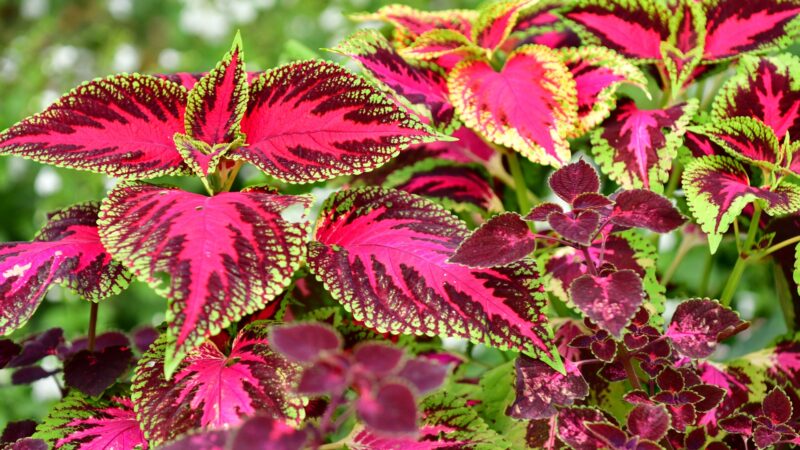
Unlike most annual plants, Coleus are grown for the ornamental value of their foliage and not their flowers since the former comes in a wide range of sizes, shapes, and colors. They are popular since the Victorian era and are used today as summer bedding plants or as color accent plants placed in patios, containers, porches, and garden terraces.
- Botanical Name: Coleus
- Origin: Asia
- Family: Mint (Lamiaceae)
- Height: 6 inches to 3.5 feet
- Watering requirements: Requires consistent watering, especially those grown in containers. Water only when the upper 1 to 2-inch layer of the soil is dry.
- Light and Temperature: Best grown in dappled light or part shade. However, some cultivars can tolerate full, hot sun.
- Fertilizing: Administer a granular general-purpose fertilizer at the time of planting. Afterwards, fertilize once a month.
- Soil: Well-drained soil, preferably with sand or compost incorporated and with a pH level of 6.0 to 7.0.
Crosby’s Prolific
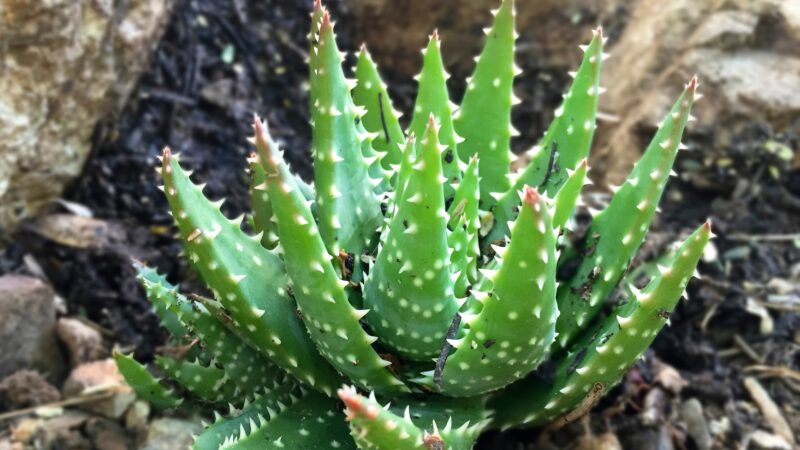
This succulent perennial is a hybrid between the Aloe humilis and Aloe nobilus characterized by its dense clump formation of stemless rosettes and dark green, several-toothed leaves that take on a red hue when exposed to light. It is a favorite among hummingbirds due to its red and yellow-tipped tubular flowers.
- Botanical Name: Aloe ‘Crosby’s Prolific’
- Origin: Hybrid
- Family: Asphodelaceae
- Height: 6 to 12 inches
- Watering requirements: Most succulents do not require a lot of water, this cultivar especially so. Water deeply but infrequently and allow the soil to dry out in between waterings.
- Light and Temperature: Does well in bright sunlight but can tolerate light shade, especially during hot summer months. They are not hardy to temperatures below 55°F.
- Fertilizing: Does not require any fertilizer, but you can add some lightly during the growing season if you wish to boost its growth.
- Soil: Ideally porous, well-draining soil. A cactus mix can be used.
Croton
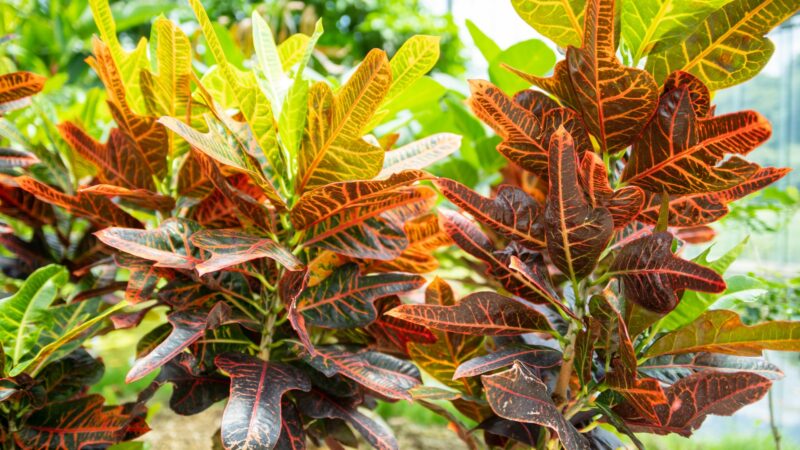
An evergreen small tree or shrub is a common houseplant but is also widely used as a specimen plant in gardens or around buildings and landscape hedges. It has thick, leathery leaves that are mainly green but variegated with red, white, pink, yellow, purple, or orange and speckled with random or regular patterns. When grown indoors, it rarely flowers.
- Botanical Name: Codiaeum variegatum
- Origin: Western Pacific and Tropical Asia
- Family: Spurge (Euphorbiaceae)
- Height: Up to 10 feet
- Watering requirements: Water moderately and do so on the upper half-inch to one-inch layer of the soil. Reduce watering during the winter season.
- Light and Temperature: Performs best in warm temperatures of 60ºF to 85ºF, bright but indirect light, and locations with moderate to high humidity
- Fertilizing: Fertilize once or twice in the growing season, but you can increase this if you want faster growth.
- Soil: Prefers well-drained, fertile, and moist soil.
Fittonia
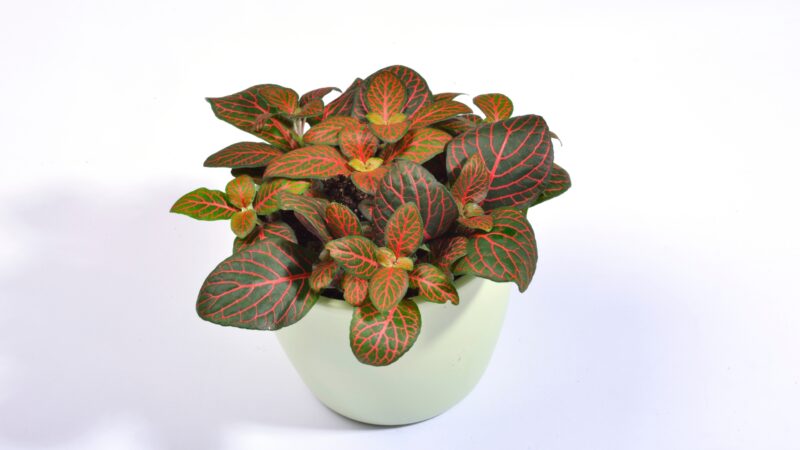
Fittonia is a group of hairy herbs characterized by their low or creeping growth and are native to moist forests. In commercial trade, they are referred to as Silver Nerve Plants due to their opposite leaves that have colored veins. It has red-veined varieties such as the ‘Verschaffeltii,’ ‘Miniature Variegated,’ and ‘Rubrovenosa Pink.’
- Botanical Name: Fittonia
- Origin: Andes, South America
- Family: Acanthaceae
- Height: 3 to 6 inches
- Watering requirements: Water once every 3 to 4 days in the growing season and let the soil dry out in between waterings. Reduce watering during the winter season, about once every 2 weeks.
- Light and Temperature: These plants enjoy bright, indirect light and temperatures between 65°F to 80°F.
- Fertilizing: Use 2.5 pounds of 9-3-6 fertilizer when administering for mass plantings or 4 grams of 19-6-12 for container-grown plants every 3 months.
- Soil: Grows well in a potting mix that uses a peat-moss base.
Jelly Bean Plant
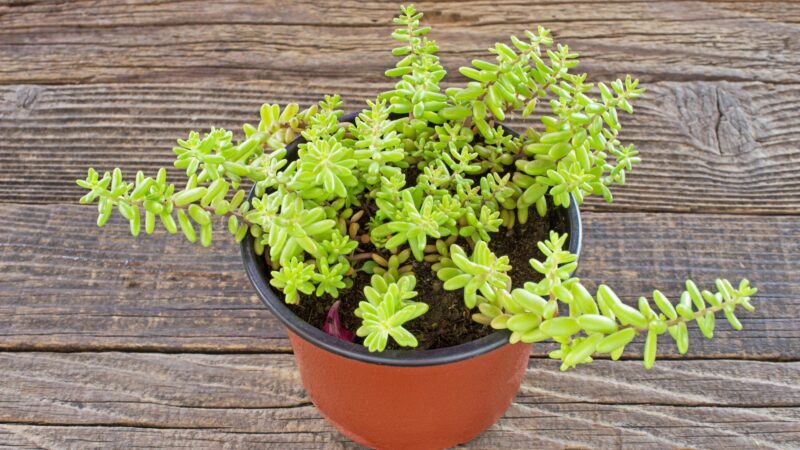
Also referred to as Pork and Beans, this succulent has chubby, green, and red-tipped leaves that are fragile when moved or bumped into. It is considered mildly toxic for pets, which is why it’s best to keep it out of the reach of children too. Jelly Bean Plants can be propagated through leaf and stem cuttings.
- Botanical Name: Sedum rubrotinctum
- Origin: Mexico
- Family: Stonecrop (Crassulaceae)
- Height: 7 to 8 inches
- Watering requirements: Does not require frequent watering but water thoroughly once you do and only when the soil is completely dry or roughly every 9 to 14 days.
- Light and Temperature: Thrives under full sun exposure and temperatures between 65°F to 80°F but can tolerate temperatures of 20°F to 30°F.
- Fertilizing: This does not require frequent fertilization since it can grow in nutrient-poor environments, but you can administer an all-purpose cactus or succulent fertilizer.
- Soil: Well-drained soil, preferably sand, or pumice mixed with peat or perlite.
Lipstick Echeveria
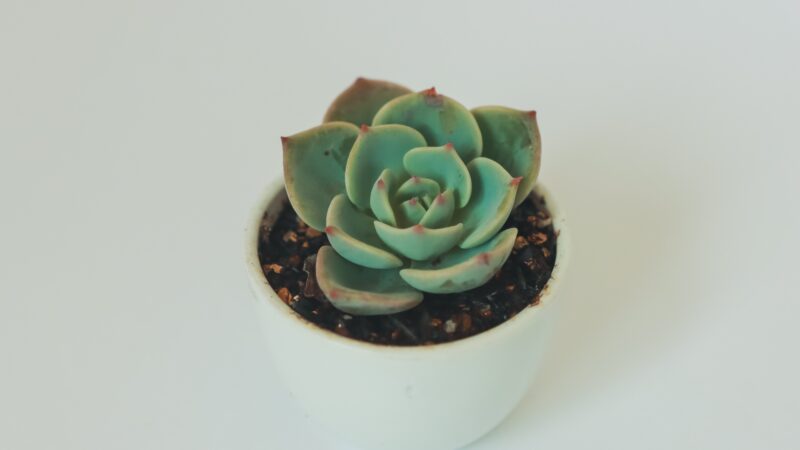
Lipstick Echeveria gets its name from the red tips found on the edges of its succulent, rosette-shaped green leaves. It also grows white, pink, yellow, or red flower stalks that hummingbirds and bees particularly love. This plant can be used in rock gardens or container plantings.
- Botanical Name: Echeveria agavoides ‘Lipstick’
- Origin: Mexico
- Family: Stonecrop (Crassulaceae)
- Height: Up to 6 inches
- Watering requirements: Reduce water supply right before they enter their dormant stage in the summer
- Light and Temperature: Prefers being in full sun. In fact, the color of its leaves will improve if placed under sunlight. This plant thrives in temperatures of 65°F to 80°F.
- Fertilizing: This does not require fertilizer at all since it is used to growing in poor conditions. However, you can try adding a little amount of slow-release fertilizer in the early summer.
- Soil: Grows in well-drained soil that is sandy or loamy.
Madagascar Dragon Tree
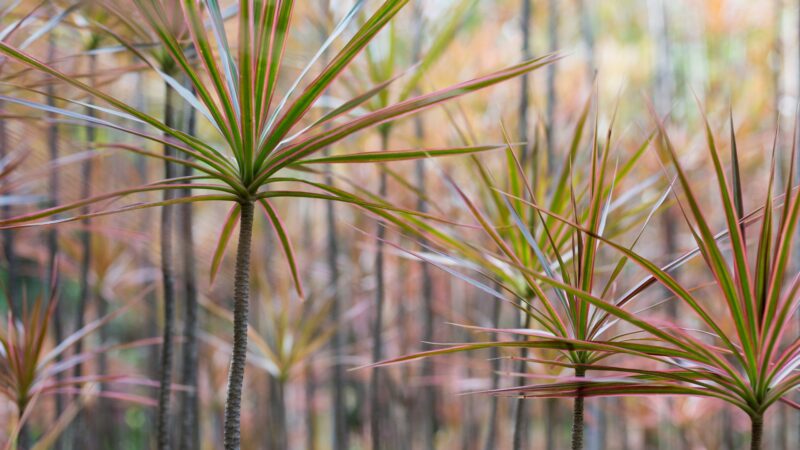
Also referred to as the Red-edged Dracaena, the Madagascar Dragon Tree is a striking plant that is easy to grow and has been cultivated since the 1930s in the United States, although it was already being grown in greenhouses during the Victorian era in Europe. Its leaves are green and marginated with red, hence its common name, as well as gray, rope-like stems.
- Botanical Name: Dracaena marginata
- Origin: Madagascar
- Family: Asparagus (Asparagaceae)
- Height: Up to 8 feet
- Watering requirements: Thoroughly water the plant and let it dry sufficiently in between waterings. Like other dracaenas, this species is sensitive to fluoride, so use non-fluorinated or distilled water.
- Light and Temperature: Prefers bright but indirect light with shade on its upper canopy and temperatures of 65°F to 80°F.
- Fertilizing: Generally, this plant does not require heavy fertilizing. Feed once in the spring, summer, and fall seasons using a controlled-release fertilizer.
- Soil: Ideally, neutral to slightly acidic loam soil that is organically rich.
Paddle Plant
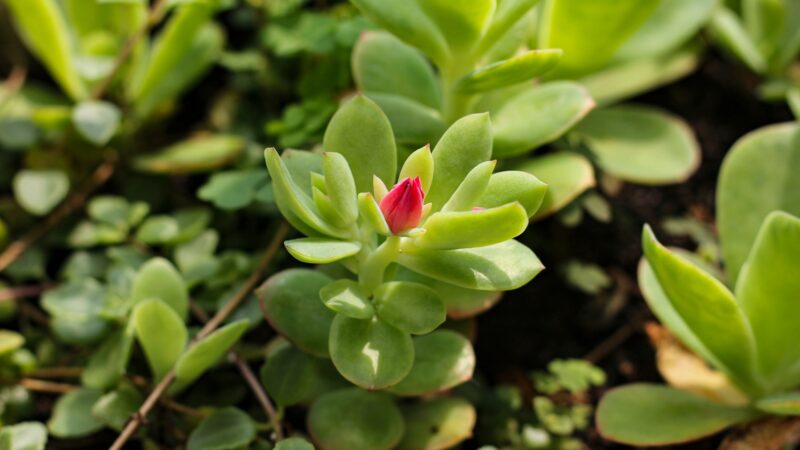
The Paddle Plant, also referred to as Desert Cabbage and Dog Tongue, is a white-frosted, drought-tolerant succulent characterized by having large, paddle-shaped, fleshy, chalky blue-green leaves that have reddish to brownish, blunt, and rounded edges. Its leaves are covered with a powdery bloom to protect them from potential sunburn.
- Botanical Name: Kalanchoe thyrsiflora
- Origin: South Africa
- Family: Stonecrop (Crassulaceae)
- Height: 2 to 3 feet
- Watering requirements: Water only when dry. During the winter season, water infrequently to prevent root rotting.
- Light and Temperature: Grows best under full sun exposure and temperatures between 60°F to 85°F. Avoid giving it too much shade, as it will grow spindly and not develop any of its attractive red tips.
- Fertilizing: Fertilize only in its active growing season using a specialized succulent fertilizer or a water-soluble fertilizer diluted to half-strength.
- Soil: Requires well-drained soil, ideally with gravel mulch, so that it can hold more moisture.
Painter’s-Palette
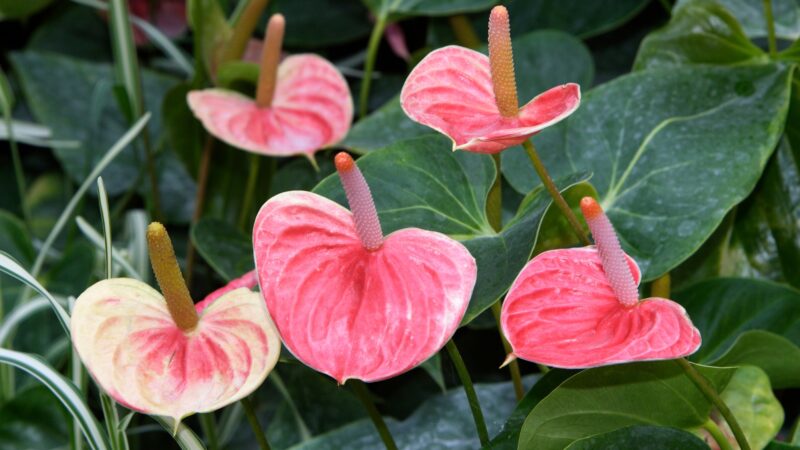
Also referred to as the Flamingo Lily, this evergreen perennial is noted for its appealing waxy, palette-shaped leaves and bright red spathes that contrast its dark green foliage. They also produce flowers that are long-lasting and, rarely, fruits. Painter’s-Palette may become an aggressive spreader, which is why it’s great as a groundcover.
- Botanical Name: Anthurium andraeanum
- Origin: Colombia and Ecuador
- Family: Arums (Araceae)
- Height: Up to 18 inches
- Watering requirements: Water every 2 to 3 days when the plant is grown in hot areas. In areas where there is frequent rain, water only when necessary.
- Light and Temperature: Needs diffused sunlight in the summer season and bright light for the rest of the year. They thrive in temperatures of 65°F to 80°F during the summer and a minimum of 60°F in the winter.
- Fertilizing: Requires a small amount of organic fertilizer once a week.
- Soil: Well-drained soil with an adequate amount of moisture.
Poinsettia
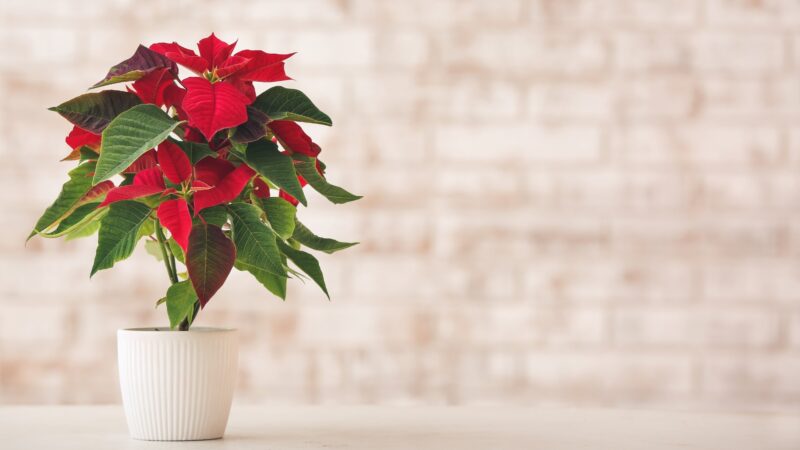
Commonly used as holiday plants due to their small yellow flowers and colorful, attractive leaves that vary from a traditional bright red to pink to creamy white, depending on the variety. Poinsettias are extremely popular flowering plants. In fact, more than 70 million plants are sold in the United States yearly.
- Botanical Name: Euphorbia
- Origin: Mexico
- Family: Spurge (Euphorbiaceae)
- Height: 2 to 13 feet
- Watering requirements: Water when the upper surface of the soil is dry or when the pot feels light when lifted. Don’t allow the plant to sit in excess water but don’t let it dry out too much.
- Light and Temperature: When grown indoors, they should receive bright daylight. When grown outdoors, make sure the plant gets 4 to 6 hours of sun daily. Temperatures of 65°F to 70°F are the most ideal.
- Fertilizing: Does not require fertilizer during the holidays, although it does need it when it grows new leaves or stems. When it does, use an all-purpose household plant fertilizer every 3 to 4 weeks.
- Soil: Grows in consistently moist but well-draining soil.
Polka Dot Plant
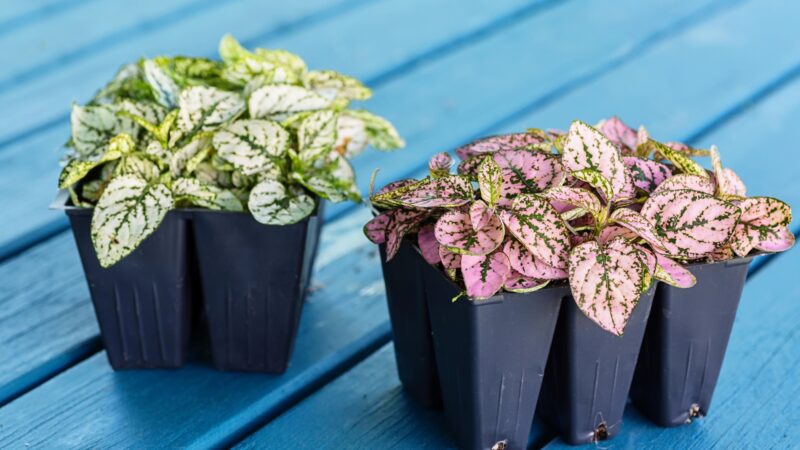
This tropical plant is popular as both a houseplant and an outdoor annual, as it is used for making borders look lively and adding substance to container plantings. The Polka Dot Plant, as the name suggests, has pink, white, bright red, or light green spots covering its small, dark green leaves. It also produces tubular blue or pink flowers and may have colored stems.
- Botanical Name: Hypoestes phyllostachya
- Origin: Madagascar, South Africa, and Southeast Asia
- Family: Acanthaceae
- Height: Up to 30 inches
- Watering requirements: Despite being somewhat drought tolerant, this plant still grows better if given plenty of water, especially when it is actively growing. The soil should be allowed to dry slightly in between waterings.
- Light and Temperature: This plant should be placed in a location where it can receive bright light. Artificial light can also be used. It thrives in temperatures of 70°F to 75°F and high humidity.
- Fertilizing: Once the plant has been established, use a diluted liquid fertilizer periodically.
- Soil: Porous soil that is rich in organic matter.
Radiator Plants
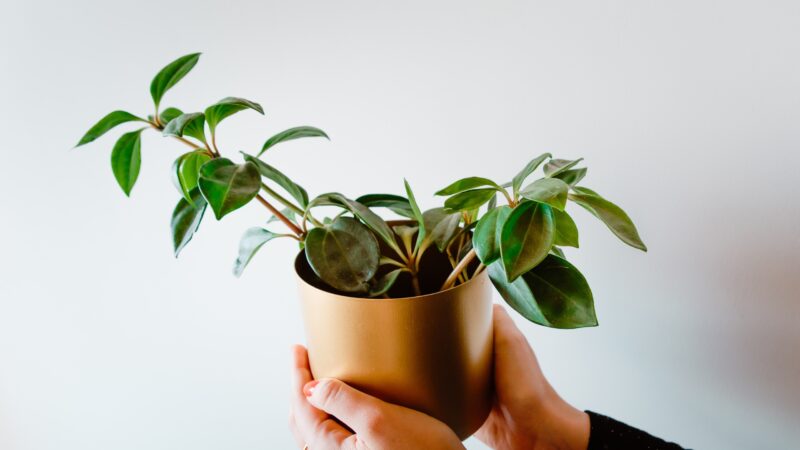
Characterized by having thick, waxy, paddle-shaped leaves with striking red margins and stems, Radiator Plants are attractive houseplants that are ideally paired with Poinsettias when decorating indoor living spaces for the holidays. Although primarily grown for their foliage, they also produce rows of small flowers.
- Botanical Name: Peperomia
- Origin: South and Central America
- Family: Pepper (Piperaceae)
- Height: Up to 1 foot
- Watering requirements: Water once every 1 to 2 weeks and allow the soil to dry out in between waterings since these plants are sensitive to waterlogged soil
- Light and Temperature: Grows best in bright light with temperatures of 65°F to 75°F but can tolerate low light levels. However, some species, specifically those with variegated leaves, can lose some of their foliage colors in poor lighting conditions.
- Fertilizing: Administer a liquid fertilizer at least once a week to ensure a gradual increase in fertility.
- Soil: Well-drained soils that are preferably rich in humus and kept dry during the winter months.
Red Air Plant
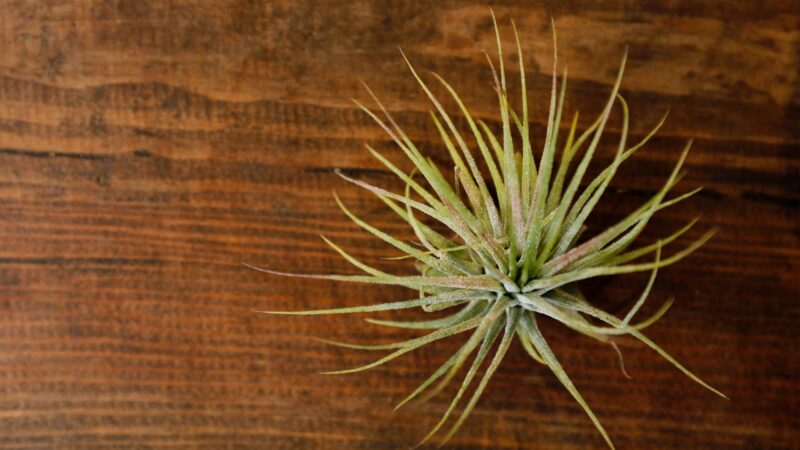
Generally, air plants are unusual and extremely unique houseplants as they do not require any soil to survive. They are native to tropical and subtropical areas where they can be found clinging onto branches or trunks of other plants or simply sitting on buildings and rocks. The ‘Red’ variety is characterized by red and green, narrow leaves.
- Botanical Name: Tillandsia ionantha ‘Red’
- Origin: Central America and Mexico
- Family: Bromeliad (Bromeliaceae)
- Height: 2 to 12 inches
- Watering requirements: Performs best with constant and abundant moisture. Submerge the plant in room temperature water for 30 minutes to 1 hour, then shake the plant to prevent water from accumulating in the leaves. Turn them upside down and wait for them to dry before returning them to their growing location.
- Light and Temperature: Requires bright but indirect lighting and temperatures of 50°F to 90°F.
- Fertilizing: Dilute a balanced, all-purpose fertilizer at half or quarter strength to the water you use for the plant. Apply every 3 to 4 waterings.
- Soil: Air plants can grow without any soil and should not be planted in one. Instead, they can be placed in containers or mounted on objects.
Red Fountain Cordyline
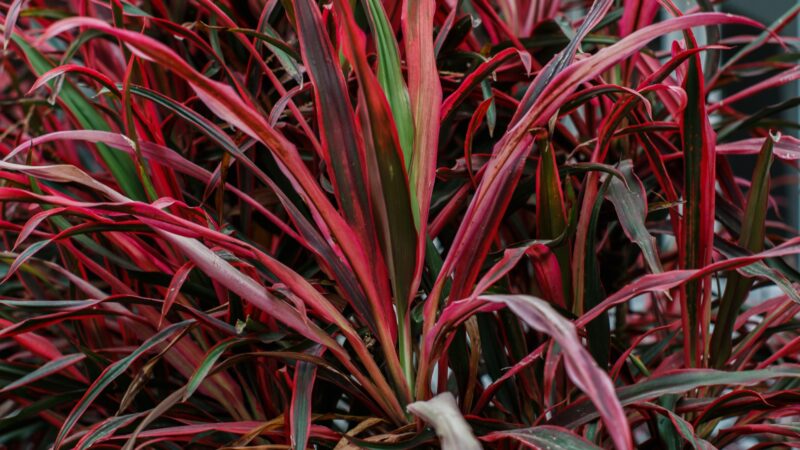
The Red Fountain Cordyline is characterized by long, cascading, burgundy-colored leaves with multiple short stems that sprout from its base, making it look like it has a deep red, grassy look. It is best used as an architectural plant for landscapes in garden beds and around pools. It is also used in contemporary gardens, specimen planting, and container planting.
- Botanical Name: Cordyline ‘Red Fountain’
- Origin: New Zealand
- Family: Asparagus (Asparagaceae)
- Height: Up to 40 inches
- Watering requirements: Water regularly at the time of the planting until it becomes established, as well as during periods of extreme heat.
- Light and Temperature: Grows best in bright, indirect light but can also be grown in shaded areas.
- Fertilizing: Apply a small amount of controlled-release fertilizer around the plant’s base.
- Soil: Thrives best in well-drained, organically rich soil, but they are tolerant of poor soil conditions.
Red Gold Aglaonema
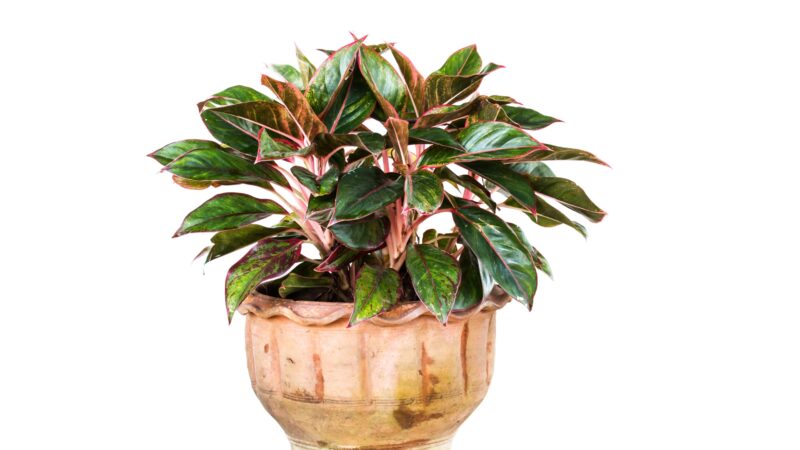
This plant is a hybrid selection of the Chinese Evergreen, which has glossy green foliage, marginated with red and streaked with red and yellow. The Red Gold Aglaonema will produce optimum foliage color when light conditions are reached. This is why it must be placed in an unobstructed window facing east or north when planted indoors.
- Botanical Name: Aglaonema ‘Red Gold’
- Origin: Unknown
- Family: Arum (Araceae)
- Height: 1 to 3 feet
- Watering requirements: Water only when the soil volume is at least half dry but don’t let it completely dry out. Reduce watering starting from early fall to the late winter season.
- Light and Temperature: Best grows in bright, indirect light or diffused sun exposure. It thrives in temperatures of 60°F to 85°F and high humidity.
- Fertilizing: Feed monthly during the spring and summer seasons using a general-purpose houseplant fertilizer that is diluted to half-strength. Do not fertilize in the winter season.
- Soil: Potting soil that is peat-based and mixed with perlite is the best option. The soil should be loose and slightly acidic.
Red Heart Philodendron
A sturdy climber with glistening heart-shaped, reddish leaves, red stems, and burgundy veins, the Red Heart Philodendron ‘Burgundy’ is a cultivar that is a common and easy-to-grow houseplant. Not only does it provide aesthetic value to your living spaces, but it is also known to purify the air around it.
- Botanical Name: Philodendron erubescens ‘Burgundy’
- Origin: Unknown
- Family: Arum (Araceae)
- Height: 2 to 3 feet
- Watering requirements: Water thoroughly when the upper one-inch layer of the soil is dry but make sure there is no excess water in the soil.
- Light and Temperature: Grows best in bright, indirect light, but they can tolerate low light or partial shade. Optimum temperatures are between 60°F to 85°F.
- Fertilizing: Feed once or twice a month using a 10-10-10 or 15-15-15 diluted to half strength.
- Soil: pH levels should not be less than 5.8 and not exceed 7.5. Mixing vermiculite, sphagnum peat moss, or perlite in the soil will produce the best results.
Red Maple Bonsai
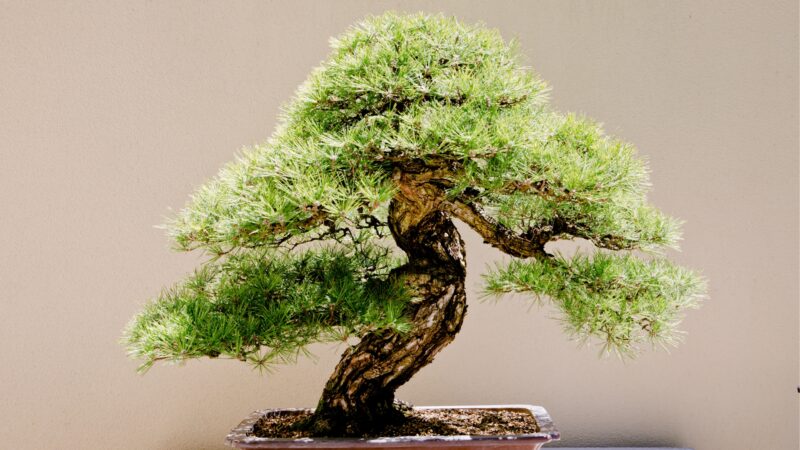
Also called the Japanese Maple, this short tree has both upright and weeping growth habits, depending on the variety. Its leaves start as green during the summer and deepen into yellow, orange, red, and purple as it grows through the fall season. This species is primarily used for landscapes but can also be utilized as a specimen or accent tree.
- Botanical Name: Acer palmatum
- Origin: Japan and Southeast Korea
- Family: Soapberry (Sapindaceae)
- Height: Up to 20 feet
- Watering requirements: Watering weekly is sufficient for the plant’s growth but increases when the soil gets too dry, like on windy days. Water should not be allowed to accumulate in the soil or around the roots.
- Light and Temperature: Requires partial sun or shade through its upper canopy all day and can tolerate temperatures as low as -20°F.
- Fertilizing: Feed in the early spring season, before new leaf growth emerges, using a liquid-type fertilizer.
- Soil: Soil should be evenly moist but has good drainage.
Red Pagoda
Also called Shark’s Tooth, this succulent has primarily green, triangular leaves that gradually turn red, orange, or bright pink during the winter season and white flowers during the summer season. The Red Pagoda is a low-maintenance plant that can be used as accents in rock gardens, as a groundcover, planted in containers, or as combination plantings.
- Botanical Name: Crassula corymbulosa
- Origin: South Africa
- Family: Stonecrop (Crassulaceae)
- Height: 6 to 10 inches
- Watering requirements: Requires little water. Allow the soil to dry out between waterings, then reduce during the summer and winter seasons.
- Light and Temperature: Allow the plant to receive at least 4 hours of bright sunlight daily. This plant is not hardy to temperatures below 32°F.
- Fertilizing: Feed using a nutrient-balanced fertilizer once during the early spring, then another time halfway through the growing season.
- Soil: Grows best in soil that is loose, well-ventilated, and is added with organic matter.
Red Veined Nerve Plant
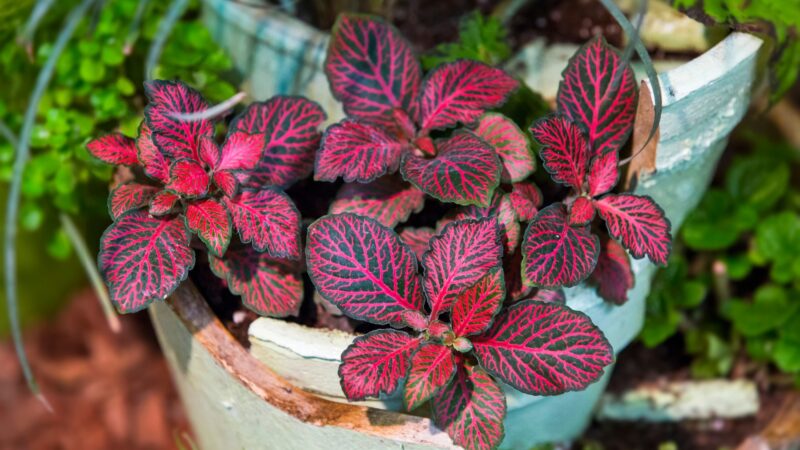
The Red Veined Nerve Plant is commonly grown as a low-growing houseplant that is best planted on a hanging basket, in a pot, or as groundcover for interiorscapes. As its name suggests, it has non-pubescent, deep green leaves that are veined in red, white, or pink. It also grows white, tubular flowers that are inconspicuous.
- Botanical Name: Fittonia albivenis
- Origin: Columbia and Peru
- Family: Acanthus (Acanthaceae)
- Height: Up to 8 inches
- Watering requirements: The recommended watering schedule is twice a week. Do not let the plant dry, or else it will wilt.
- Light and Temperature: Thrives on medium to bright light or under fluorescent lights, medium relative humidity, and temperatures between 65°F to 80°F.
- Fertilizing: Feed using a small dose of liquid fertilizer, such as a half-strength 5-5-5 fertilizer, weekly during the growing season
- Soil: Prefers moist, well-drained loam soil that is ideally peat-based and slightly acidic.
Salsa Rex Begonia
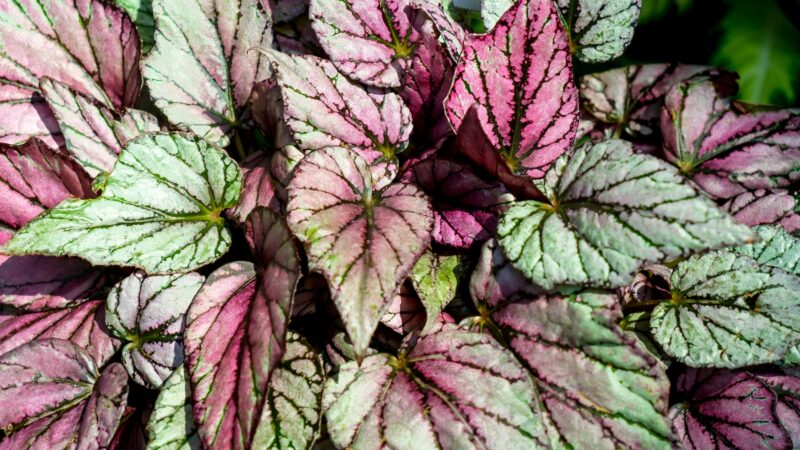
Salsa Rex Begonia is a cultivar of rex begonia characterized by silver leaves that are variegated with shades of burgundy and green. This plant is well-suited for windowsills, hanging baskets, or houseplants. It can also be planted in landscapes to add a vibrant dimension and appearance to them.
- Botanical Name: Begonia rex-cultorum ‘Salsa’
- Origin: India
- Family: Begonia (Begoniaceae)
- Height: Up to 8 inches
- Watering requirements: Requires regular watering, but the upper third layer of the soil should dry out first before watering again.
- Light and Temperature: This plant prefers environments with bright but indirect or curtain-filtered light, high relative humidity, and temperatures of 60°F to 80°F.
- Fertilizing: Feed once a month using foliar feed that has nitrogen as the main ingredient. Balanced fertilizers like 7-9-5 and 15-15-15 can work.
- Soil: Prefers saturated soil with a pH level of 5.7 to 6.4, ideally with a peat-based soil mix. Add manure and organic compost for optimum plant growth.
Succulents
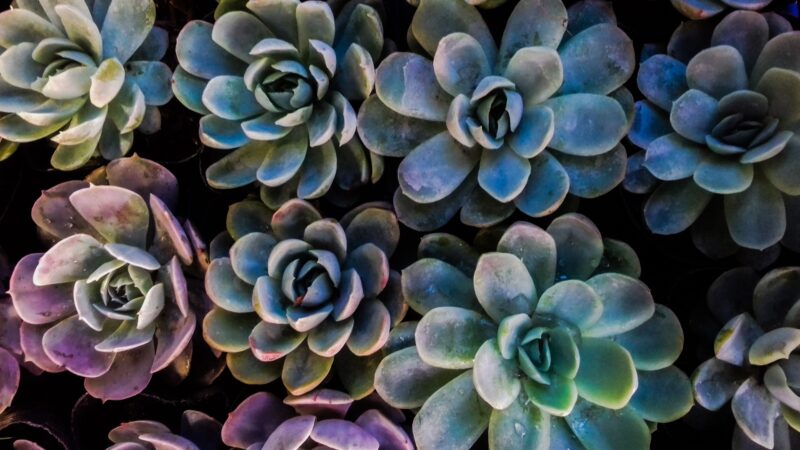
Succulents refer to a group of drought-resistant plants that are characterized by their thick, fleshy leaves and/or stems. They are found in a variety of plant families, which include the cactus family (Cactaceae). A notable example of a succulent with red and green leaves is the Moon Cactus (Gymnocalycium Mihanovichii).
- Botanical Name: N/A
- Origin: N/A
- Family: Belongs to many families
- Height: Up to 12 feet, depending on the species
- Watering requirements: These plants hold water well in their fleshy leaves, which makes them tolerant to extreme heat conditions. Water weekly during the spring and summer seasons.
- Light and Temperature: Prefers bright, indirect light, but some species can tolerate shade. Most succulents thrive in temperatures of 55°F to 75°F.
- Fertilizing: Feed a balanced fertilizer during the spring and summer months or a water-soluble fertilizer every 3 to 4 waterings.
- Soil: Requires well-draining soil that does not hold too much water and dries out quickly. They prefer soil mixtures that consist of one-third organic content and two-thirds mineral material.
Ti Plant
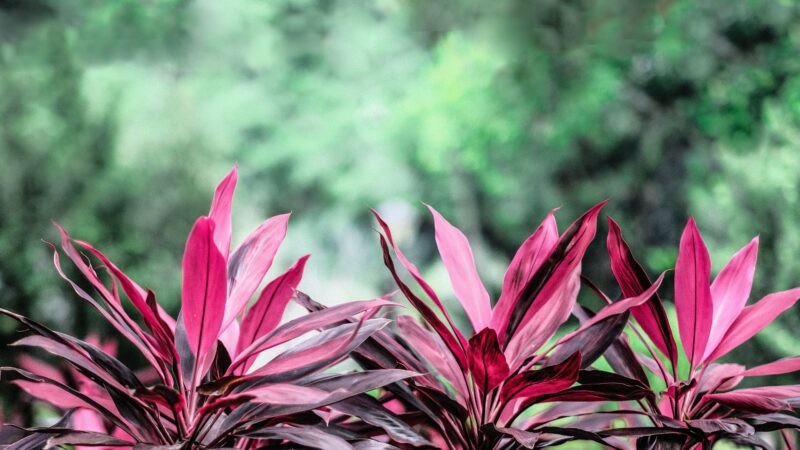
An upright, evergreen shrub with red or purple and green leaves, yellow flowers, and round, inconspicuous red fruit, the Ti Plant is grown for its ornamental value as an accent plant or in mass planting for larger landscapes. It is commonly used in Hawaii as a component for making dancing skirts.
- Botanical Name: Cordyline fruticosa
- Origin: Unknown
- Family: Asparagus (Asparagaceae)
- Height: Up to 15 feet
- Watering requirements: Water the plant only when the upper layer of the soil feels dry. If possible, use distilled water or any other fluoride-free water as it is sensitive to fluoride.
- Light and Temperature: Prefers bright light but would require shading, especially in Western regions to keep its foliage from fading. Optimum temperatures range from 60°F to 85°F.
- Fertilizing: Low amounts of slow-release fertilizer or about 150 parts per million (ppm) of liquid fertilizer is sufficient
- Soil: Grows best in soil medium with peat and well-drained bark. It is not tolerant of salt.
Wandering Jew
Grown for its variegated green to purple foliage, the Wandering Jew is a popular houseplant characterized by its inconspicuous lavender or white flowers, oval-shaped fruits, and succulent stems. The cultivar ‘Purpusii’ possesses reddish-green or dark red leaves while ‘Quadricolor’ has leaves that are striped with red, white, and green.
- Botanical Name: Tradescantia zebrina
- Origin: Central America, Mexico, Colombia
- Family: Spiderworts (Commelinaceae)
- Height: 6 to 9 inches
- Watering requirements: Regular watering should be provided but the plant’s soil should be dried out in between waterings
- Light and Temperature: Performs best with bright light indoors and in the light shade outdoors, at temperatures of 60°F to 80°F
- Fertilizing: Use half the strength of an organic water-soluble fertilizer every two weeks during the growing season. Feed only when there is new growth of leaves.
- Soil: Slightly alkaline, moist but not excessively wet soil, preferably with organic matter. It has poor tolerance towards salt content in the soil.
List of Sources
Bromeliads – https://hort.extension.wisc.edu/articles/bromeliads/
Coleus – https://extension.umn.edu/flowers/coleus
Cordyline Terminalis Ti Plant – https://edis.ifas.ufl.edu/publication/FP141
Peperomia: Foliage for the Holidays – https://njaes.rutgers.edu/plant-of-the-month/peperomia.php